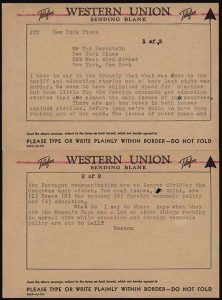Main Exhibit Page | A Stormy Tenure as Executive Editor | Mr. Reston Goes to China | Credits and Exhibit Sources

Transforming the Washington Bureau
Upon his promotion to Washington Bureau Chief on October 1, 1953, Scotty began transforming the bureau into a dynamic news organization. He disapproved of what he saw as his predecessor’s myopic vision of journalism: the routinized pursuit of facts and adherence to objectivity at the expense of context and analysis; the focus on war and politics at the expense of science, economics, and education. [1] Scotty believed newspapers could no longer hold these outdated ideas given the proliferation of radio and television networks capable of rapidly disseminating breaking news stories across the globe. Instead, newspapers needed to provide analytical stories as an alternative to these emerging media.[2] Scotty infused the bureau with this ideal. He encouraged reporters to uncover the motivations of key players by perceiving events through their subject’s perspective to develop queries that culled candid observations.[3] To implement his vision, Scotty looked to a new generation of talent eager to follow in his footsteps.

An Eye for Talent
Scotty began recruiting talented young reporters to become specialists in their chosen fields, reasoning that it was impractical to expect journalists to cover myriad topics in the complex post-war era.[4] Anthony Lewis, whom Scotty hired in 1955, reflected this trend. Scotty assigned Lewis to cover the Supreme Court, first sending him to Harvard Law School in 1956 and 1957 to prepare for the assignment.[5] Lewis’s training enabled him to grasp the intricacies of American jurisprudence, prompting the curmudgeonly Supreme Court Justice Lewis Frankfurter to praise the young reporter’s adroit analysis.[6]
Scotty also began an internship program for recent college graduates at the Washington Bureau in 1961 based on the Supreme Court’s clerk program.[7] Developed by Justice Frankfurter, who believed the infusion of youth at the court kept him in touch with the world. Steve Roberts, who clerked for Scotty in 1964, recalled decades later that Scotty embraced Frankfurter’s philosophy, demanding his intern’s input, instead of their mindless praise. This attitude endeared Scotty to Roberts, who later admitted that ‘I’m a newspaper columnist today because my hero did it.’[8]
The Murky Transition from Bureau Chief to Associate Editor
By the early 1960s, Scotty had reached the pinnacle of his profession, spurring Time magazine to characterize Reston as a ‘Man of Influence,’ in a February 1960 cover issue.[9] Ironically, Scotty influence began to wane shortly thereafter. Arthur Hays Sulzberger suffered a series of strokes, forcing him to cede his position as publisher to his son-in-law, Orvil Dryfoos on April 25, 1961. Dryfoos’s tenure as publisher was short-lived: he died unexpectedly from heart failure on May 25, 1963.[10] Arthur Hays Sulzberger’s son, Arthur Ochs “Punch” Sulzberger, was next in line of succession. Unlike his father and brother-in-law, Punch had few personal ties to Scotty, having established a closer relationship with Turner Catledge, the managing editor of the New York Times, who opposed the power Arthur Hays Sulzberger had accorded Scotty. On September 2, 1964, Scotty, realizing his eroding leverage at the Times, stepped-down as Bureau Chief to become an associate editor,[11] marking the end of one of the happiest periods of his life. The next chapter would prove much less rewarding.
Steve Roberts discusses his clerkship under Reston, Undated.
Found in RS 26/20/157, Card File Box 3: Roberts, Steve (2) and Schmitt, Eric
Continue to: A Stormy Tenure as Executive Editor
Footnotes:
[1] Max Frankel, The Times of My Life and My Life with the Times (New York: Random House, 1999), 106; James Barrett Reston, “The Tyranny of Deadlines,” June 1945, James B. Reston Papers, 1935-1995; Record Series 26/20/120, Box 4, Folder: Diary Entries, 1942-43, 45, 1987, University of Illinois Archives; Untitled Speech, ca 1985, James B. Reston Papers, 1935-1995; Record Series 26/20/120, Box 22, Folder: Speeches, University of Illinois Archives.
[2] John F. Stacks, Scotty: James B. Reston and the Rise and Fall of American Journalism (Boston: Little, Brown, 2003), 92; Draft speech for Pulitzer Prize 50th Anniversary, ca 1964, James B. Reston Papers, 1935-1995; Record Series 26/20/120, Box 20, Folder: Memoirs—Pulitzer Prize 50th Anniversary, University of Illinois Archives.
[3] Stacks, Scotty, 92; Frankel, The Times of My Life, 216-221-222, 228; James Reston, Deadline: A Memoir (New York: Random House, 1991), 203, 205.
[4] John F. Stacks, Scotty, 167.
[5] Adam Liptak, “Anthony Lewis, Supreme Court Reporter Who Brought Law to Life, Dies at 85,” The New York Times, March 25, 2013, accessed March 3, 2016, http://www.nytimes.com/2013/03/26/us/anthony-lewis-pulitzer-prize-winning-columnist-dies-at-85.html?_r=0.
[6] Felix Frankfurter to James Reston, January 8, 1958, James B. Reston Papers, 1935-1995; Record Series 26/20/120, Box 102, Folder: E.C. Daniel, 1957-63, University of Illinois Archives.
[7] “Sketches: Memoirs of the Clerks to James Barrett Reston,” September 15, 1979, James B. Reston Papers, 1935-1995; Record Series 26/20/120, Box 39, Folder: Clerks Memoirs 1979, 1984, University of Illinois Archives; Reston, Deadline, 173-174. Johnathan Yardley was Scotty’s first clerk (1961-62), followed by Christopher Willoughby (1962-63), Donald E. Graham (1963), and Steven V. Roberts (1964-65).
[8] Tape Recorded Interview with Steve Roberts,” Undated, John F. Stacks Papers, 1914-2003; Record Series 26/20/157, Care File Box 3, University of Illinois Archives.
[9] “The Press: Man of Influence,” Time, February 15, 1960, 74-80.
[10] Stacks, Scotty, 215-218; “Sulzberger Retires as Time Publisher, Remains Chairman; Dryfoos Successor,” The New York Times, April 26, 1961, accessed March 25, 2016, ProQuest Historical Databases.
[11] Susan E. Tifft and Alex S. Jones, The Trust: The Private and Powerful Family Behind the New York Times (Boston: Little, Brown, 1999), 324; Frankel, The Times of My Life, 217-218, 272.